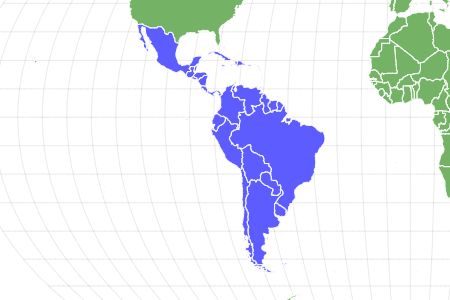Macaw
Arini
The military macaw is named for the green uniforms that many soldiers use in South America.
Advertisement
Macaw Scientific Classification
- Kingdom
- Animalia
- Phylum
- Chordata
- Class
- Aves
- Order
- Psittaciformes
- Family
- Psittacidae
- Genus
- Arini
- Scientific Name
- Arini
Read our Complete Guide to Classification of Animals.
Macaw Conservation Status
Macaw Facts
- Main Prey
- Fruit, Nuts, Seeds, Insects
- Fun Fact
- The military macaw is named for the green uniforms that many soldiers use in South America.
- Distinctive Feature
- Large colourful body and curved beak
- Wingspan
- 3-4 feet
- Incubation Period
- Up to 28 days
- Habitat
- Rainforests and tropical jungle
- Diet
- Omnivore
- Lifestyle
- Flock
- Favorite Food
- Fruit
- Type
- Bird
- Slogan
- The largest species of parrot in the world!
- Nesting Location
- Tall trees, riverbanks and cliffsides
- Age of Molting
- 9-10 months
- Migratory
- 1
There are approximately 17 unique species of Macaw birds in the wild and in captivity today. All these birds are part of the Psittacidae family, which translates to “true parrots.” This parrot family further splits into two subfamilies: the Psittacinae and the Arinae, or Old World and New World parrots, respectively.
Old World parrots include the Grey Parrot, the Cape Parrot and the Senegal Parrot, which are found primarily in Africa. In contrast, New World Parrots include six genera of Macaw birds that live and roam in Mexico, Honduras, Brazil and other nations in Central America and South America. These birds include the scarlet Macaw, the blue and gold Macaw, the green wing Macaw, the red-shouldered, or Hahn’s, Macaw, and the harlequin Macaw.
See all of our expert product reviews.
Unlike their Old-World cousins, these all have bright feathers in varying shades of green, blue, yellow, gold, and red. While these colors are very vibrant and attractive to humans, these colors allow Macaw birds to camouflage themselves in the green leaves of the Amazon rainforest and other forests that they call home.
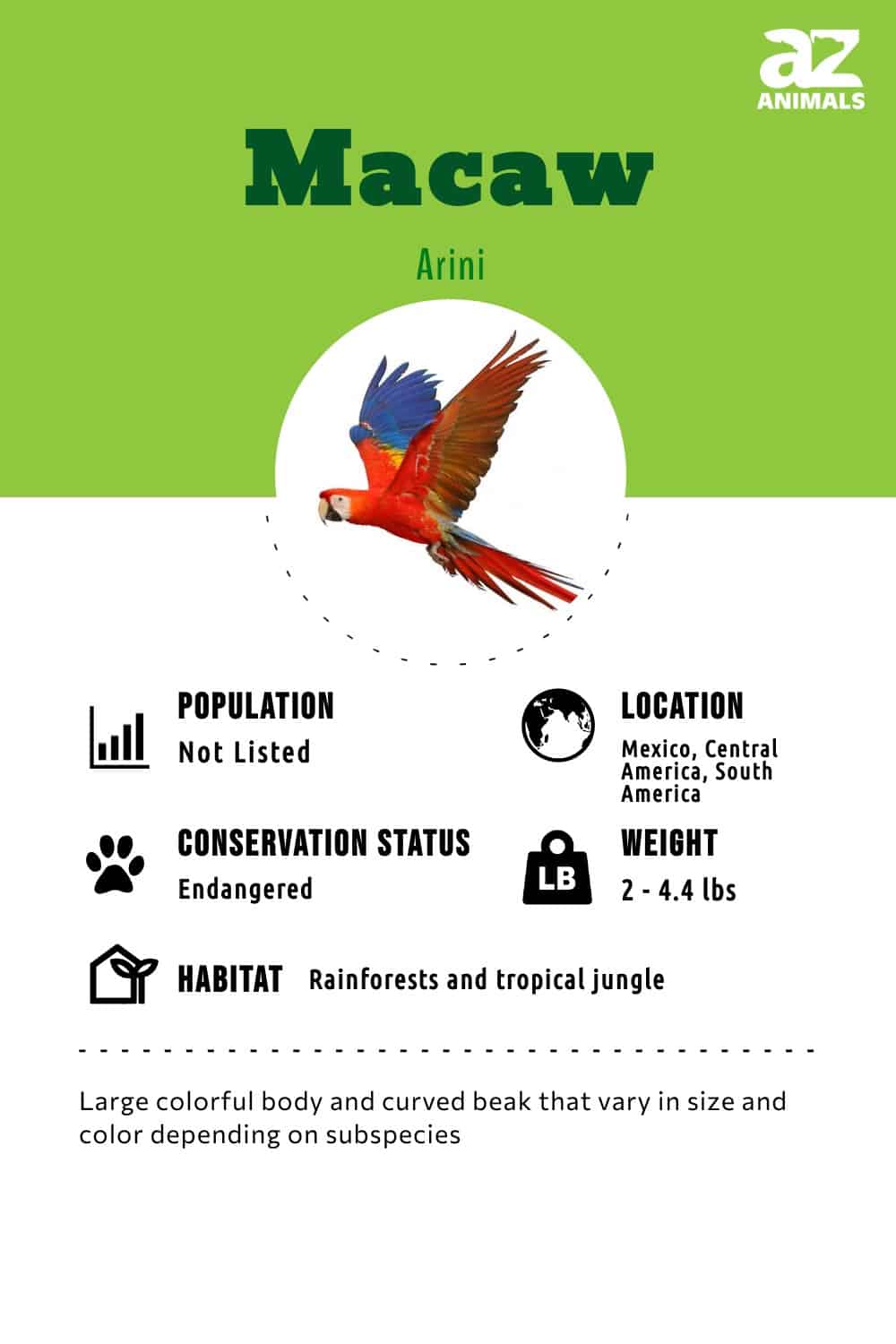
An Amazing Bird: 4 Macaw Facts
- These birds are long-lived; their lifespan can reach up to 60 years or more, even in the wild.
- They are playful birds and will use their feet, beaks, and tongues to explore new objects.
- The Hyacinth Macaw is the largest of all flying parrot species. It can reach up to three feet long and weigh up to four pounds.
- There are over 17 different species of this bird, many of which are at risk for extinction.
Read other interesting Macaw facts here.
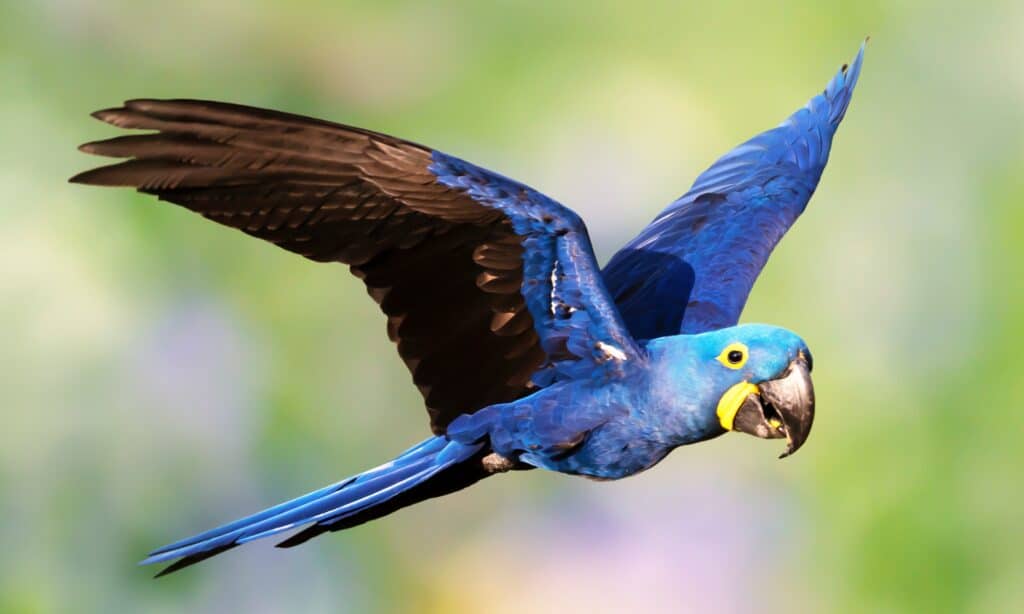
The Hyacinth Macaw is the largest of all flying parrot species.
©Dgwildlife/Shutterstock.com
Where to Find Them
The blue and gold and hyacinth species of these birds are native to Central America and South America. They can be seen in the wild in such countries as Mexico, Honduras, and Brazil. Their unique feathers and bright coloring help them blend into the Amazon rainforest and their other natural habitats.
Health and Entertainment for your Macaw
See all of our expert product reviews.
These birds generally live in monogamous pairs but also form families of up to 30 in one flock. They generally settle into the crevices within tall trees or live on cliffsides for protection. They have also been known to dig out depressions in riverbanks or other hills made from soft earth.
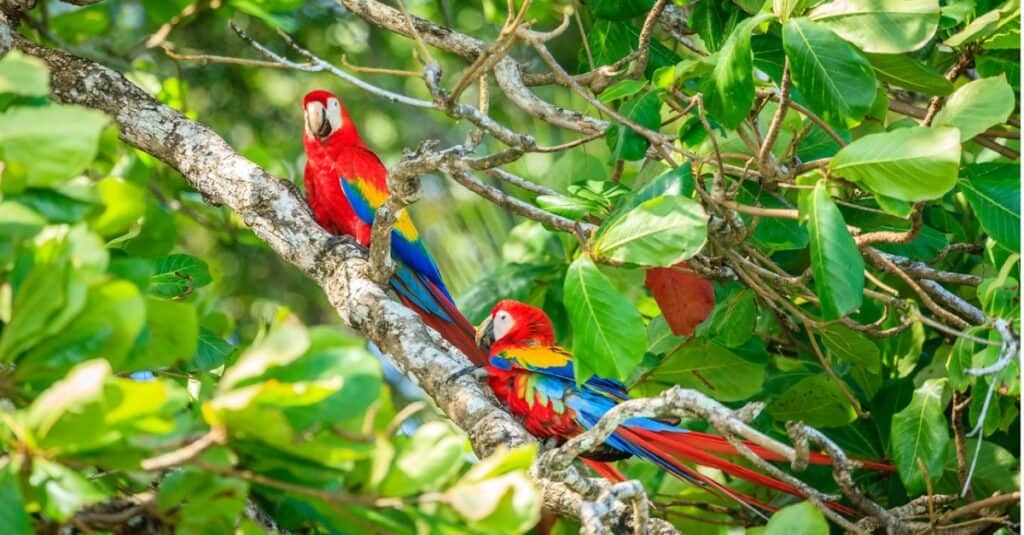
Macaws’ unique feathers and bright coloring help them blend into the Amazon rainforest and their other natural habitats.
©iStock.com/alexeys
Scientific Name
Due to the large number of living species, there are numerous scientific names for these birds. In general, all 17 of these species are found in the Psittacidae, or true parrot family. Further, they are part of the Arinae, or New World parrots, subfamily and the Arini tribe of Macaws and parakeets.
The six genera of living Macaws are as follows:
- Ara, which includes the scarlet (Ara macao) and the green wing Macaws (Ara chloropterus)
- Primolius, a genus that includes smaller, mostly green Macaws such as the blue-headed (Primolius couloni) and the yellow-collar Macaws (Primolius auricollis)
- Orthopsittaca, the genus of which the red-bellied Macaw (Orthopsittaca manilatus) is a part
- Diopsittaca, a genus that contains only the red-shouldered Macaw (Diopsittaca nobilis). This species has two subspecies including the noble Macaw and the Hahn’s Macaw.
- Anodorhynchus, which includes the Hyacinth Macaw (Anodorhynchus hyacinthinus)
- Cyanopsitta, a genus of which the Spix’s Macaw (Cyanopsitta spixii) is the only living member
Due to their cheerful nature, their vibrant coloring and their ability to learn words, many birds of this species are popular pets. This status has led breeders to create some hybrid species in captivity. For example, the harlequin is a new breed that is a cross between the blue and gold and the green wing species. Harlequins generally have personality and coloring elements from both species.
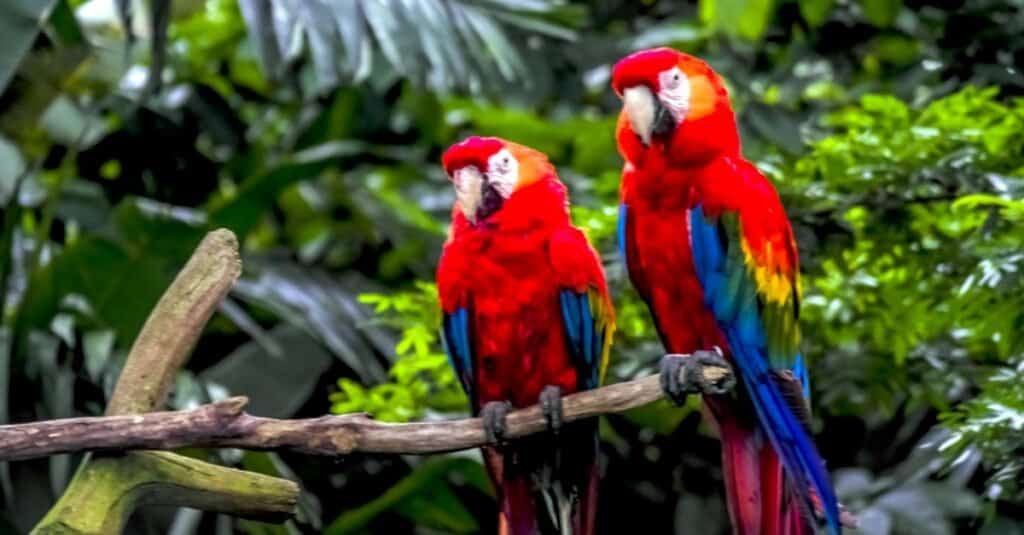
Scarlet Macaws are curious, strong-willed, and highly trainable. It is one of the most intelligent bird species in the world and is able to mimic words and sounds and learn tricks in captivity.
©iStock.com/MagicColors
Size, Appearance & Behavior
These are generally playful and happy birds. Their owners have described them as clowns or jokers. They are highly social creatures both in the wild and in captivity. Many do well with families where they have more humans to interact with on a regular basis. If they are hand-fed from an early age, then they will become attached to their owners.
In the wild, these are curious birds. Scientists and enthusiasts have observed these birds playing with new objects. They will often toss new things into the air and catch them with their beaks or their feet. They also will lick and taste the object to try and get more information about it.
While these birds bond in pairs, they also typically seek to form larger flocks of 30 to 40 or more birds. Increased numbers serve to protect themselves from humans, snakes, larger birds, jaguars and other threats. Macaws often shriek or let out loud noises to communicate with or to warn their flock mates. In captivity, they like to learn words and will practice new vocabulary until they master it.
As you can imagine, the average size, weight, and wingspan varies widely from species to species. The largest examples are part of the Ara genus. This group includes the hyacinth Macaw, which has a wingspan between three and four feet and weighs up to four pounds. It is also more than 39 inches long.
The smallest species is the red-shouldered Macaw (scientific name Diopsittaca nobilis), which is also known as the mini-Macaw. These birds weigh only 5.8 ounces and only 12 inches long. The Hahn’s Macaws and noble Macaws that make up this species are almost identical in appearance. However, the Hahn’s has a black upper mandible.
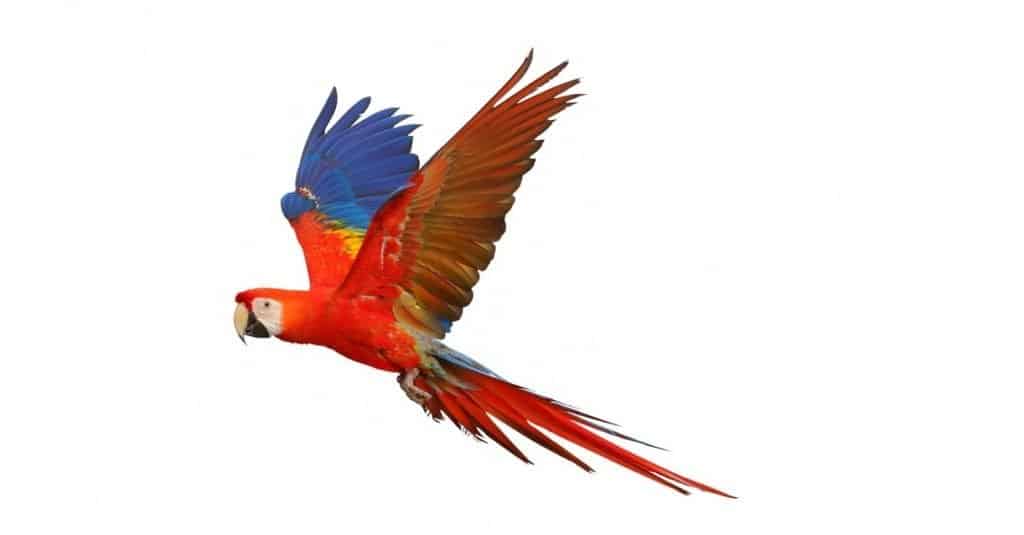
The hyacinth Macaw has a wingspan between three and four feet and weighs up to four pounds.
©Passakorn Umpornmaha/Shutterstock.com
Nests
These birds normally nest in the knots or crevices in tall rainforest trees. Some species also make their homes in rotted-out trees on the savannas and plains in South America. Other species will opt to nest on rocky cliffs for protection while some will choose to dig out an area in a riverbank.
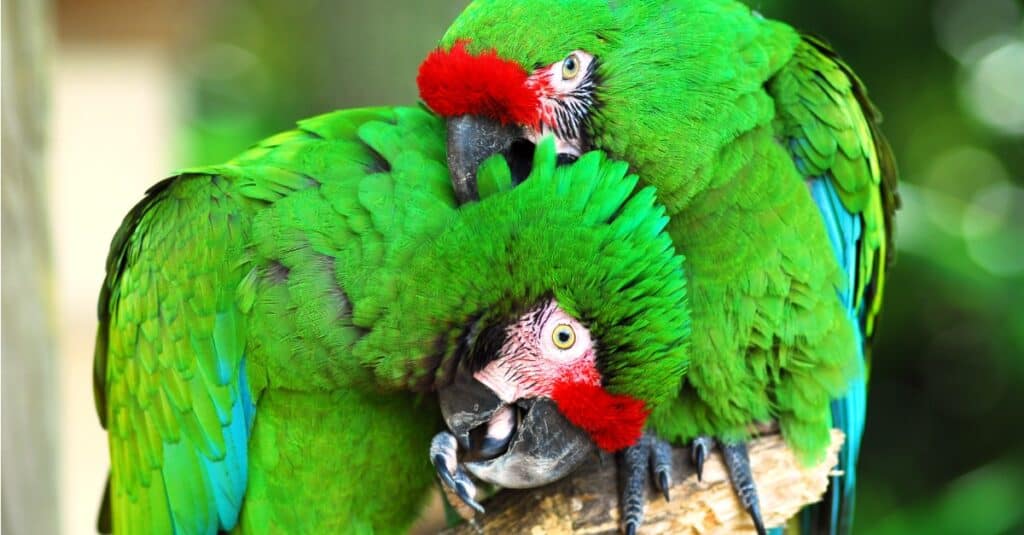
Macaws normally nest in the knots or crevices in tall rainforest trees.
©iStock.com/Musat
Diet
Macaws primarily eat fruit as their main source of nutrition. However, they do also fly to grassy areas in search of seeds or nuts. Their strong beaks are capable of cracking almonds, brazil nuts, and other similar nuts. Nuts’ higher caloric value and fat content are important to larger species like the hyacinth Macaw.
For a complete analysis of the diet of macaws, don’t miss our ‘What Do Macaws Eat: 11 Foods in their Diet‘ guide!
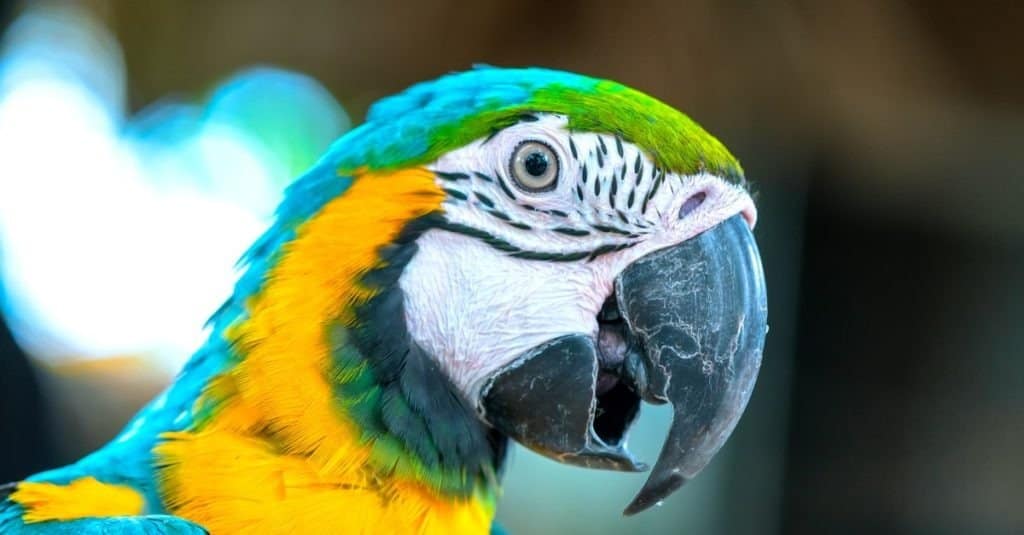
Types of Macaws
There are many types of macaws, and here are several of the most popular:
- Hyacinth Macaw – They Hyacinth Macaws are blue with black beaks and yellow eyerings. They can be found in South America. These are the largest types of this bird species, and they are notorious for being difficult to manage as a pet. Therefore, they are not suggested for pet owners who do not know exactly what they are getting themselves into!
- Military Macaw – Despite how their name sounds, the Military Macaw can be curious, social, and pleasant; however, they still need a lot of attention and are not for the novice pet owner. They have green feathers with a red head, and they can be found from Mexico south to Argentina.
- Scarlet Macaw – The Scarlet Macaw is large with a strong, curved beak and brightly colored plumage. It is composed of three distinctive color bands: red on the head and shoulders, yellow on the back and mid-wing feathers, and blue on the wingtips and tail. The face has a patch of black and white skin as well. They can be found in South and Central America.
- Spix’s Macaw – The Spix’s Macaw can be identified by its striking blue plumage. The exact color of the body varies from the brilliant turquoise blue along its breast and abdomen to the duller bluish gray of the head. It also features gray skin, pale yellow eyes, and a black curved bill. From head to tail, an average member of the species measures around 22 inches; the elegant tail feathers are about as long as the rest of the body. This makes it slightly smaller than the typical macaw species. They can be found in Brazil.
- Hahn’s Macaws – Hahn’s Macaws are the smallest of the macaws and are known for their keen intelligence. They are able to learn some speech from a moderate amount of training. They can be found in South America. Their stomachs are a darker green, while their tails and wings are a lighter green color. They have orange irises.
- Hybrid Macaw – Hybrid Macaws are birds that have been breed from mixed macaw parents for their different qualities and traits. This gives them differing color patterns and temperaments. Only owners with a lot of knowledge about the species should take one of these home.
- Severe Macaw – The Severe Macaw are sort of a funny bird that can be very social. They form a tight bond with owners who provide the correct amount of attention and training. They also have great speech capability. They can be found in South America and also in Panama. They have chestnut-colored heads and green feathers with red feathering where their wings meet their chests.
- Yellow-collared Macaw – The Yellow-collared Macaw are also known as Golden-collared Macaws. These particular birds are known to be very intelligent, which also makes them very good at escaping and contributing to all kinds of avian mischief. While they are mostly green, they have a yellow band that wraps around their necks. They can be found in South America.
Predators and Threats
These birds are at risk from several native species in the Amazon rainforest and the forests of Central and South America. These predators include snakes, monkeys, and larger birds. Specific threats include pythons, boa constrictors, jaguars, ocelots, eagles, and falcons.
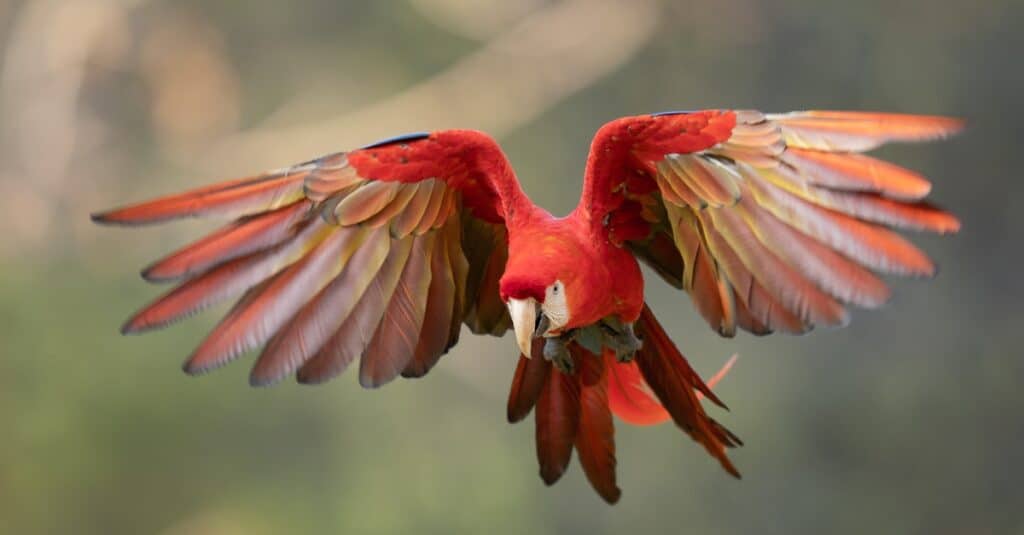
Macaws are at risk from several native species in the Amazon rainforest and the forests of Central and South America.
©iStock.com/sduben
Reproduction, Babies, and Lifespan
Macaws reach sexual maturity between two and 10 years depending upon the species. At that time, they will typically pair up and bond with another bird in their flock. Most clutches have between one and four eggs. If reproduction is successful, then females will generally wait two years to mate again.
The eggs normally incubate anywhere between 24 and 28 days depending upon the type of Macaw. Chicks will typically remain in the nest under their parents’ protection for up to three months after hatching. At that point, they will often stay with their parents and siblings for a year and then head off to find their place in a flock.
A Macaw’s lifespan varies significantly based upon its species. For example, the blue and gold Macaw will live up to 35 years in the wild. In comparison, the green wing and scarlet Macaws have a lifespan between 70 and 75 years. Overall, these birds average 60 years in the wild, but some individuals do survive into their 80s and beyond.

Chicks will typically remain in the nest under their parents’ protection for up to three months after hatching.
©CHUCHAT TREEPRAPHAKORN/Shutterstock.com
History and Evolution
Macaws are known for their brilliant plumage and striking color. But what makes them so colorful?
Many other types of brightly colored birds derive their coloration from their diet within their environment. Macaws are that way! They are able to produce those colors through chemical pigments within their bodies and also through structural adaptations of spaced microscopic layers within their feathers.
The bright colors are part of their defensive strategy and work well because macaws tend to stay within their flocks for protection. Would-be predators have a hard time visibly discerning body shapes because of the bright plumage.
Population
The Macaw population varies significantly depending upon which species you evaluate. Some species, like the Spix Macaw are extinct in the wild. In fact, less than 200 of these birds left in captivity worldwide.
In contrast, there are believed to be at least 10,000 blue and gold Macaws left in the wild. This species is labeled as least concern because its numbers, while still declining, have remained relatively stable over the last decade.
Other species, like the hyacinth Macaw, are endangered and considered threatened. There are only an estimated 6,500 specimens of these birds left in the wild. Similarly, there are only about 2,000 scarlet Macaws left in the world.
View all 164 animals that start with MMacaw FAQs (Frequently Asked Questions)
Are Macaws herbivores, carnivores, or omnivores?
Macaws are Omnivores, meaning they eat both plants and other animals.
What Kingdom do Macaws belong to?
Macaws belong to the Kingdom Animalia.
What phylum do Macaws belong to?
Macaws belong to the phylum Chordata.
What species does a macaw belong to?
There are currently 17 different macaw species in the wild or in captivity. All these species belong to the Psittacidae family, which means “true parrots”. The macaw species are split between six different genera within the Psittacidae family.
Can a macaw talk?
Yes, macaws can talk. In fact, these birds have been known to practice words and new vocabulary until they get the pronunciation correct.
Where are macaws found?
Macaws are native to Central America and South America.
Does the Macaw migrate?
It depends. The scarlet macaw is known to migrate to Belize and other areas in search of fruit, seeds, nuts and other food. However, many macaw species, such as the blue and gold and hyacinth macaws, do not migrate. They choose to remain in bonded pairs with total flocks between 30 and 40 birds.
How many eggs does the Macaw lay?
Typical macaw clutches include one to four eggs. The mother keeps the eggs warm for between 24 and 28 days and the chicks remain in the nest for up to 90 days after being born.
How fast does the Macaw fly?
Many species, including the Hyacinth macaw, the green-wing macaw and the scarlet macaw, have achieved top speeds of around 35 miles per hour. The red-fronted macaw (Ara rubrogenys) has been recorded at speeds around 40 miles per hour.
What is the Macaw’s Wingspan?
The macaw’s wingspan varies significantly depending upon its species. The largest macaws, the hyacinths, have wingspans between three and four feet. As a comparison, the red-shoulder macaw has a 12-inch wingspan and is one of the smallest birds within the six macaw genera.
When do Macaws leave the nest?
Fledgling macaw chicks first attempt to leave the nest about three months after they first hatch. However, they frequently remain with their parents for at least one year before seeking their own place within the flock.
Can you have a macaw as a pet?
It depends; because many species are endangered or critically endangered, it may be illegal to purchase or keep a macaw in captivity. Other times you will need to obtain a special license or permit before purchasing your bird.
Macaws from responsible and licensed breeders are extremely popular as pets because of their beautiful looks, their fun personalities and their intelligence.
How much does a macaw cost?
The price for these birds depends upon the size and rarity of the species, amongst many other factors. As an example, a smaller macaw, like the red-shoulder species, will typically cost between $700 and $1,000.
Specially bred hybrid macaws, like the Harlequin species, have a price tag between $1,000 and $5,000 or more. Scarlet macaws, one of the most-well known species, normally have a purchase price between $2,000 and $3,000.
What class do Macaws belong to?
Macaws belong to the class Aves.
What family do Macaws belong to?
Macaws belong to the family Psittacidae.
What order do Macaws belong to?
Macaws belong to the order Psittaciformes.
What genus do Macaws belong to?
Macaws belong to the genus Arini.
What type of covering do Macaws have?
Macaws are covered in Feathers.
What is the main prey for Macaws?
Macaws eat fruit, nuts, seeds, and insects.
What are some distinguishing features of Macaws?
Macaws have large colorful bodies and curved beaks.
What is an interesting fact about Macaws?
Macaws are the largest species of parrot in the world!
What is the scientific name for the Macaw?
The scientific name for the Macaw is Arini.
What is the lifespan of a Macaw?
Macaws can live for 50 to 60 years.
How do Macaws have babies?
Macaws lay eggs.
What's the difference between macaws and parrots?
There are some differences between parrots and macaws, even though all macaws are technically parrots. Macaws are larger than most parrot varieties, and parrots are found in more locations worldwide compared to macaws.
What is the difference between Cockatoo and Macaw?
- The main difference between a cockatoo and a macaw is that cockatoos are smaller, generally harder to care for, and are native to Australia and Asia. Macaws are usually larger, a bit easier to care for, and are native to Central and South America.
What are the differences between Lear's macaws and hyacinth macaws?
The key differences between Lear’s macaws and hyacinth macaws are distribution, mating habits, and ecological threats.
Thank you for reading! Have some feedback for us? Contact the AZ Animals editorial team.
Sources
- San Diego Zoo, Available here: https://animals.sandiegozoo.org/animals/macaw
- Wikipedia, Available here: https://en.wikipedia.org/wiki/Blue-and-yellow_macaw
- Amazon Aid Foundation, Available here: https://amazonaid.org/species/macaw/#:~:text=Larger%20birds%20of%20prey%2C%20snakes,a%20few%20insects%20for%20food.
- Sea World Parks & Enterainment, Available here: https://seaworld.org/animals/facts/birds/blue-and-gold-macaw/
- National Geographic, Available here: https://www.nationalgeographic.com/animals/birds/group/macaws/
- See the Wild, Available here: https://seethewild.org/macaw-facts/#:~:text=Macaws%20belong%20to%20the%20Parrot,60%20years%20in%20the%20wild.
- Federal Register, Available here: https://www.federalregister.gov/documents/2018/08/13/2018-17319/endangered-and-threatened-wildlife-and-plants-listing-the-hyacinth-macaw#:~:text=The%20overall%20population%20estimate%20for%20the%20hyacinth%20macaw%20remains%206%2C500%20individuals.%20Jump%20to%20top

